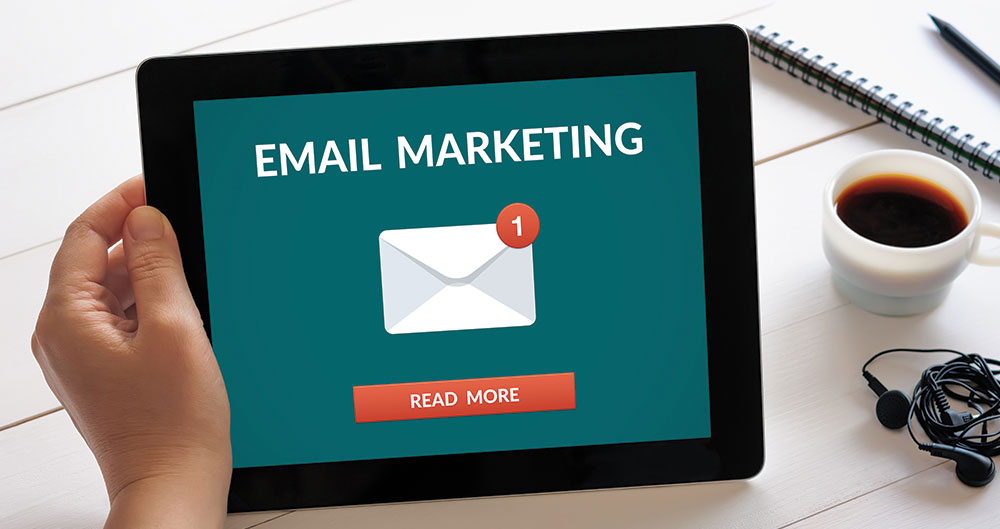Basic Email Best Practices for Building Product Manufacturers
October 17, 2019

Staying in touch with customers through email is a no-brainer: it’s easy and effective. But when you don’t follow email best practices, you might mistakenly think it’s neither of those things. If you fall into this camp (and even if you don’t), we’ve got five tips to help you send better emails to home builder prospects and existing customers.
To start, though, let’s clarify what we’re talking about. When we say better emails, we don’t mean the one-offs you send from your personal account, we mean email marketing. Coordinated emails created by a marketing team that go out to a list of home builders that have either shown interest in your brand or are already customers.
Why email marketing?
Depending on the size of your company, you could already have a marketing team or an outside agency that handles email campaigns. Or, alternately, maybe you’re an emerging manufacturer and you don’t have a formal process. We’re going to cover our bases here and make a case for email marketing in general.
Do you know how 58 percent of people start their day? Email! It’s one of the most popular forms of communication with more than 90 percent of people between the ages of 15 and 64 using it. And more than that, OptinMonster found that 99 percent of people check their email every day, while iVend Retail found that 62.9 percent of internet users worldwide prefer to receive email communications from retailers more than any other way (and for our purposes, we’ll treat selling building products as a retailer).
Practically speaking, it’s also a less intrusive way to stay in touch with and retain customers (the importance of which we discussed in our post, “Are You Neglecting Your Existing Builder Base? 5 Strategies for Customer Retention”).
Email is also readily available to most people, as 81 percent of Americans own smartphones. So how do you maximize your opportunities here? Follow these best practices.
Not yet a HomeSphere partner?
HomeSphere manufacturer partners have access to the largest community of home builders in the United States.
Know the stats to look for
The smartest way to succeed in email marketing is to measure your results, which is why we’re starting with it. Too often, marketers send out emails and then fail to reflect on how they perform. Here are some good indicators on whether an email has succeeded or not:
Open rate. The percentage of people who opened your email. While you want this percent to be high, it’s not realistic to expect it to be 100 percent. As Mailchimp breaks it down, you’re doing better than average if you beat 21 percent. (Use that link to compare averages for most of the indicators mentioned here.)
Click rate. The percentage of people who clicked on a link in the email. This percentage is found by dividing the number of clicks by the number of emails delivered. It helps indicate whether your email was persuasive enough to inspire the user to click through your email to your website, a landing page or etc.
Click-to-open rate. The number of unique clicks divided by the number of unique opens. This percentage complicates things a bit but is worth looking into if you have the resources. Instead of dividing the number of clicks by total emails delivered, this rate only divides by the number of unique opens. That way, you get a better idea of whether your content was persuasive enough based on the actions of the people who actually opened the email.
Bounces. The percentage of users who didn’t receive your email because of a temporary reason (soft bounce) or because their email address doesn’t exist (hard bounce). The bounce rate will let you know if your email list is good or not. If it’s high and most of the bounces are hard bounces, you have a bad email list.
Spam/abuse reports. The number of users who reported your email as spam. This one is self-explanatory. Email servers will start sending your emails straight to spam if too many people report you as spam.
So, where do you find these numbers? The analytics section of your email marketing platform. If you don’t have an email marketing platform to take advantage of, there are a lot of options out there depending on your needs and how simple (Mailchimp, Constant Contact, etc.) or complex (Acoustic, Marketo, etc.) you want to get.
Send with a purpose
Always have a goal in mind when creating an email blast or campaign, and if you don’t have a reason to send an email: don’t. A goal will also help you determine the best call to action (or CTA) for your email. A CTA moves your recipient down a specific path once they open your email and is usually displayed as a button so people know to click it.
When it comes to email content, chances are you’ll want to update home builders on important announcements like new products and specials.
While marketers generally warn against being too self-promotional, it’s okay to focus on your products because they’re of value to home builders. It’s how you frame it that’s important. Don’t talk about how state-of-the-art your product is. Instead, explain why home builders will benefit by choosing your product and show them you understand their product needs.
Just keep in mind what home builders aren’t likely to be interested in, like the awards you’ve won, products that aren’t suitable for their market and company news that means nothing to them.
Pay attention to your subject line
Open rates are highly influenced by your subject line, so you’ll want to keep these best practices in mind, and play around with your style to see what resonates with your audience. You might find long, straightforward subject lines work the best. Or, maybe your audience likes short and sweet, or even ones that add a little humor.
Generally speaking, though, avoid empty promises or anything that sounds too spammy, and don’t go for the clickbait options that misrepresent what your email is actually about (like, “A year of free HVACs!” that only leads to an email about a new HVAC system you’re promoting). These options might result in opens, but your audience will be annoyed that you tricked them.
You’ll know that a subject line has left its mark by an increased amount of opens, and you’ll also know when a subject line fell flat when your usual 30 percent open rate drops to 18 percent.
Stick to a schedule
It’s easy to be tempted to only send an email when you want to promote a new product but that can lead to inconsistent communication, which isn’t ideal for keeping customers engaged. Aim for the same day or week each month to send your enewsletter or product update email, so customers will begin to expect it and even look forward to it.
If you have enough good content to share, you can certainly send more frequently. But monitor your overall email performance if you’re sending multiple communications a week to the same list. If you can see your open and click rates decreasing without having made any significant changes to your content style, you could be witnessing email fatigue. Pull back on sending as many emails and see if your rates improve.
When it comes to home builders, you’re best off scheduling your emails for the morning. They’re more likely to be in their office and checking emails than on a jobsite. Email marketers have some ideas about the day of the week you should send on, but it will also depend on your specific audience, and that’s why it’s important to test send days and times. We’ve found that some home builders are easier to reach on Fridays when the typical work week is slowing down, while other home builders are surprisingly chipper and responsive on Monday mornings.
Send to good, segmented email lists
A good email list includes builders who have specifically opted into your emails. That’s likely going to be your existing customers and builders who are interested in your product and want to learn more. You’ll know you have a good list when your bounce rates and open rates are above average. You’ll know you have a bad list when they’re below average. But to take it further, good lists are also segmented.
Email segmentation is every email marketer’s favorite term, but it’s for good reason. You won’t get good results from your emails if you’re sending to bad lists or not customizing your content to your audience.
That is, you don’t want to send the same product update emails to your custom home builder customers as your multi-family customers. Your custom builders want to hear about products that will differentiate their houses from everyone else’s, while your multi-family builders are interested in value and cost-effectiveness.
The more targeted your lists, the better you’ll be able to tailor your content. And even if your customer base doesn’t vary between multi-family and single-family, you’ll still want to be able to segment by demographics. For example, say you’re trying to push a product that’s only sold in some regions, or maybe you want to offer a special to only certain home builders.
But you can only segment by demographics if you have a good email list that includes data like a customer’s address, builder type, annual amount of houses built and so forth. This kind of data typically doesn’t come from free email lists, and you can generally only obtain it from having an engaged audience that’s opted in and has a relationship with you.
To obtain this information, you can survey your existing builder base for it. Or (shameless plug) you can partner with a company like HomeSphere that already has an established relationship with home builders, and even better, already has this demographic information.
Bonus tip: Make sure your emails are mobile-optimized
Emails are opened more often on phones than desktops now, so make sure your emails are looking pretty and are optimized for mobile usage.
Share This
More Business Blueprints
Brands on Our Program
Sorry, we couldn't find any posts. Please try a different search.






